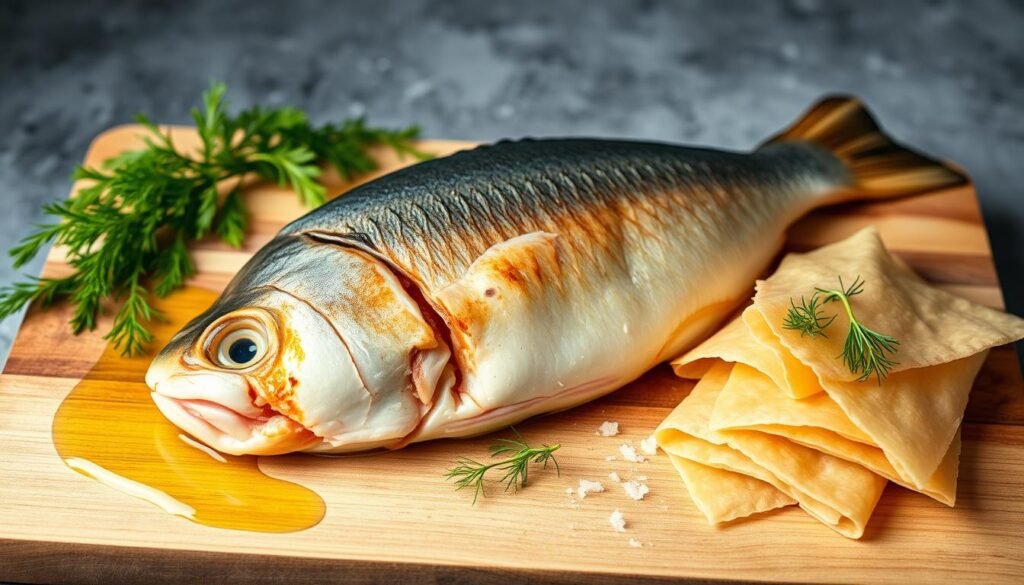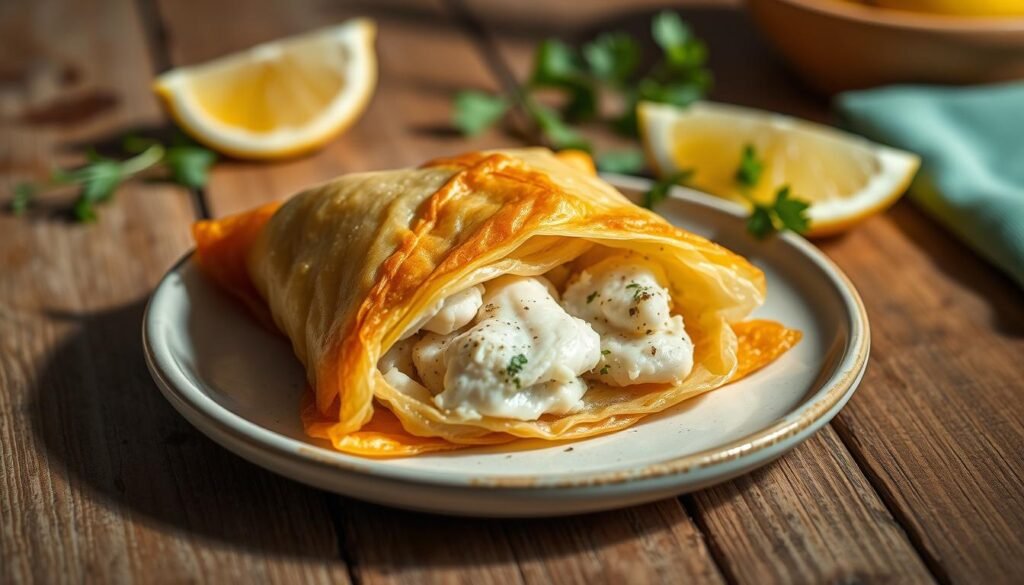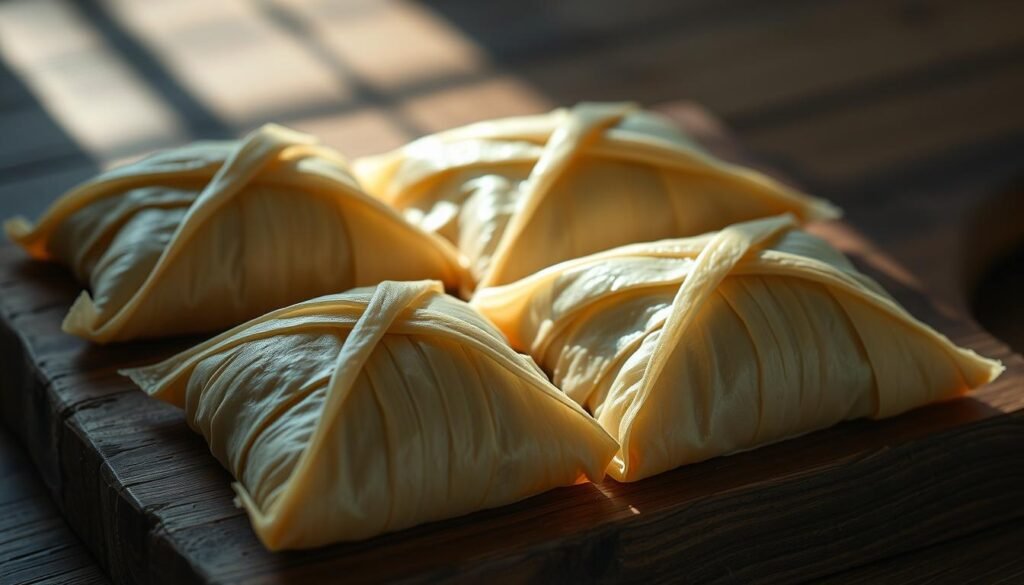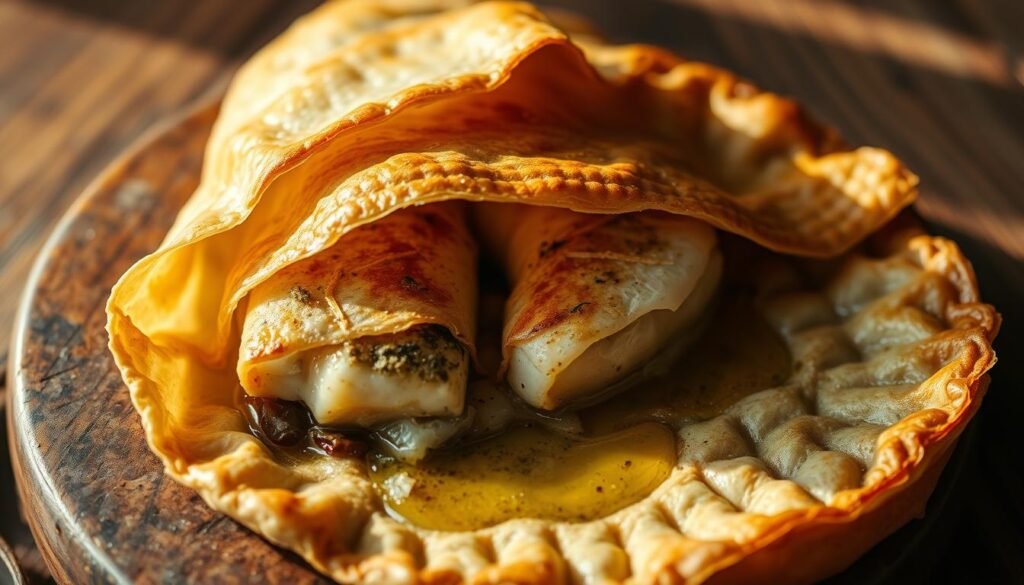My fish wrapped in filo recipe is a mix of flaky pastry and tender fish. It’s perfect for quick weeknight meals or weekend gatherings. You can use wild-caught cod or halibut, or try salmon or sea bass for a change.
Key Takeaways
- Use thicker #7 filo for sturdy crusts or thinner #4 sheets for delicate layers
- Substitute fish with halibut, hake, or salmon for different textures
- Store leftovers refrigerated up to two days; reheat at 375°F for 10-15 minutes
- Pair with seasonal salads garnished with dill and lemon zest for brightness
- Brush filo with olive oil between layers to ensure perfect golden crispiness
Ingredients That Make a Difference
Choosing the right ingredients can make a simple fish filo pastry recipe into a memorable dish. Start with fresh fish, like wild-caught cod or salmon. These fish offer rich flavor and a firm texture. Look for fish with bright eyes and a clean smell at the market.
For the filo, pick sheets labeled #7 or #4. These thicknesses wrap well without tearing.

Fresh Seafood Selection
Wild-caught white fish, like cod, is a great choice. Salmon adds a nice oiliness that complements herbs. Pat the fillets dry before rolling to prevent moisture from softening the pastry.
A 5-ounce fillet per serving ensures even cooking. Season lightly with salt, pepper, and olive oil. This enhances the fish’s natural flavors without overpowering.
Quality Filo Pastry
Filo’s delicate layers require careful handling. Keep unused sheets covered in a damp cloth to prevent drying. Brush each layer with melted butter or olive oil for golden, crisp layers.
Pair the dough with dill or parsley for brightness. Add optional toppings like spinach or cheese for extra flavor. But avoid overstuffing to keep the parcels neat.
Pro tip: Use fresh lemon zest in the filling for a citrus kick. Herbs like cilantro or basil work well too. Store-bought filo is fine—just thaw it slowly in the fridge overnight.
Step-by-Step Instructions for a Perfect Creation
Mastering the easy fish filo parcel starts with precision. Let’s break it down:
- Marinate the salmon: Toss 4-ounce salmon fillets with Greek vinaigrette for 20 minutes. This step infuses flavor without overpowering delicate fish.
- Prep veggies: Thaw spinach, squeeze dry, then mix with crumbled feta. Blanch asparagus spears briefly, then cool in ice water to retain vibrant green.
- Layer filo thoughtfully: Lay 4 thawed phyllo sheets on a flat surface. Use a damp towel to cover unused sheets, keeping them pliable. Lightly brush each layer with olive oil—this ensures golden crispiness.
- Assemble parcels: Place a salmon fillet 3 inches from the edge. Top with spinach-feta mix and a blanched asparagus spear. Fold sides over the filling, roll tightly, and seal edges by pressing gently.
- Bake to perfection: Place parcels seam-side down on a greased sheet. Bake at 425°F (220°C) for 18–20 minutes. Brushing with oil and slitting the top allows steam to escape, preventing soggy layers.

- Tip 1: Use a silicone mat to prevent sticking without extra oil.
- Tip 2: For a seafood twist, swap salmon with shrimp and crab meat blended with mayo and green onions.
- Tip 3: Let the parcels rest 5 minutes post-baking to lock in juices.
Pro tip: Brushing each phyllo layer with melted butter adds extra crunch. My go-to? A quick spray of olive oil cooking spray for busy kitchens!
My Personal Cooking Tips and Variations
Small changes can make a big difference in seafood filo pastry. Here’s how I make it extra tasty:
Enhancing Flavors with Herbs and Spices
I add fresh dill and oregano to the fish. For more flavor:
- Season each filo sheet with smoked paprika and cracked pepper before assembling.
- Mix minced garlic into the seafood mixture for an aromatic base.
- Let the seasoned fish rest at room temperature for 20–30 minutes to deepen flavor.
Experimenting with Zesty Additions
Citrus makes the dish pop. Try these:
- Zest a lemon directly onto the fish for brightness.
- Brush layers with a mix of melted butter and lemon juice.
- Garnish with chives and a drizzle of olive oil before baking.

For a lighter version, use half whole wheat pastry flour. It keeps the texture crisp and cuts carbs. These tips turn seafood filo pastry into a dish that’s all your own!
Secrets of the Fish Wrapped in Filo Recipe
Mastering crispy filo fish parcels is more than just following steps. It’s about understanding the science behind the technique. My go-to method keeps the fish tender and the filo golden and crackling. Here’s what I’ve learned through trial and error.

Why This Method Works for Me
Layering filo around the fish locks in moisture. I brush the pastry with a light egg wash and sprinkle poppy seeds before baking at 200C. This adds flavor and ensures even browning.
The key is working quickly to prevent the dough from drying out. A rushed assembly leads to those signature crispy filo fish parcels.
Overcoming Common Challenges
- Filo tears: Keep a spray bottle handy to mist the dough lightly if it cracks. Use a clean brush to press edges together seamlessly.
- Sogginess: Pat fish dry before wrapping. I layer sorrel leaves under the salmon to wick away excess moisture.
- Timing: Rotate trays halfway through the 25-minute bake. For extra crunch, switch the oven to broil for the final 2-3 minutes—watch closely to avoid burning!
Pairing crispy filo fish parcels with steamed vegetables keeps the contrast crisp-to-tender. Pro tip: Freeze unbaked parcels on a tray first, then store in a freezer bag for up to three months. Just add five extra minutes to the bake time when reheating.
Achieving the Perfect Crispiness
Getting the crunch right in baked fish in filo dough is all about technique. Preheat your oven to 350°F for even heat. Brush each layer of filo with olive oil for that golden finish.

- Brush generously: Apply oil between each filo sheet. This simple step creates layers that crisp without burning.
- Control the moisture: Defrost dough completely to prevent sogginess. Cover unused pastry with a damp cloth while working to keep it pliable but not wet.
- Score strategically: Lightly cut the top layer before baking to let steam escape—this stops the dough from puffing unevenly.
Bake for 20-25 minutes until the exterior turns golden. Use a thermometer to check the fish reaches 145°F. This ensures it’s cooked through without overbaking the dough. A quick spray of cooking oil on top right before baking adds extra crunch without greasiness.
Don’t stress if the dough tears—those cracks won’t ruin the texture. The key is patience: letting the dish cool slightly after baking lets the layers set perfectly. These steps turn every bite into a satisfying contrast of flaky, golden filo and tender fish.
The Mediterranean Twist: Flavorful Additions
Add bold, sun-kissed flavors to your filo-wrapped fish with lemon butter sauce. The Mediterranean diet brings fresh herbs, citrus, and healthy fats. These ingredients make the dish vibrant and packed with nutrients. Follow these tips to use regional ingredients and keep the recipe easy.
Incorporating Regional Ingredients
Begin with lemon juice and extra-virgin olive oil, key to Mediterranean cooking. Add minced garlic and a pinch of sumac for extra depth. Brush the filo layers with olive oil before baking for crispiness and aroma.
- Top with chopped Kalamata olives or sun-dried tomatoes for bursts of saltiness.
- Stir in chopped walnuts or pine nuts for texture, as seen in classic Greek salads and pilafs.
Balancing Traditional and Modern Flavors
I love mixing classic flavors with modern twists. The lemon butter sauce is great with smoked paprika or a drizzle of tahini for creaminess. Serve with bulgur salad or roasted veggies for a Mediterranean touch.
Try these combinations:
- Mix minced fresh dill and mint into the fish filling for brightness, as in traditional Psari Plaki recipes.
- Add a modern touch by topping with a harissa-infused yogurt sauce for heat.
- Wrap cod or haddock instead of salmon for a lighter protein option, paired with the lemon butter sauce.
Baking Techniques for Gorgeous Filo Parcels
Getting the baking right is essential for those golden, flaky Mediterranean fish filo pockets. Every step, from preheating to timing, is important. It keeps the parcels crispy without burning. Here’s how I achieve perfection.
- Preheat your oven to 375°F (190°C) for 15 minutes before baking. This ensures even cooking.
- Place the filo parcels on a parchment-lined tray, leaving 1-2 inches between each. This prevents steam buildup.
- Bake for 15-20 minutes, flipping halfway. Check the edges for a deep golden color.
I use two filo sheets for extra crunch, brushing olive oil between them. This boosts crispiness and reduces fat. Keep unused filo sheets under a damp towel to stay soft. For more texture, lightly spray the top sheet with cooking spray before baking.
Keep an eye on the parcels in the last 3 minutes. The Anathoth Farmstyle Pickle’s moisture can make them soggy if not cooked enough. Let them rest for 5 minutes after baking. This allows the filling to settle while the filo stays crisp. Serve with lemon wedges and steamed broccolini for a vibrant contrast.
Storage and Reheating Guidance for Lasting Freshness
Keeping your delicious fish filo bundles fresh starts with the right storage. Follow these tips to enjoy every bite as much as the first time.
Simple Storage Ideas
Put leftovers in an airtight container in the fridge. They last 2–3 days for the best taste. If you need to make them ahead, use puff pastry or mashed potatoes instead. Phyllo loses crispiness quickly.
- Wrap bundles in parchment paper, then place in a sealed container.
- Add a dry paper towel to absorb moisture before closing the container.
Reheating Without Sacrificing Texture
Reheat in a preheated oven at 350°F (175°C) for 10–15 minutes. Microwaves make the filo soggy. Here’s how to do it right:
- Place bundles on a baking sheet lined with parchment paper.
- Heat until the filo turns golden and crisp again.
Always check the center is warm before serving. Enjoy within 2–3 days for the best taste and crunch!
Serving Suggestions That Wow the Taste Buds
When you share your homemade filo-wrapped fish, how you present it matters a lot. Make each bite special by adding flavors and garnishes that pop. Here’s how to make this dish unforgettable.
- Pair with a crisp green salad dressed in olive oil and lemon.
- Roasted asparagus or carrots add earthy notes that balance the fish.
- Offer garlic butter rice or mashed potatoes for a hearty side.
- Drizzle with tzatziki or garlic aioli for a tangy dip.
For eye-catching plating, follow these steps:
- Cut filo parcels diagonally to show the filling.
- Arrange on a platter with lemon wedges and herb sprigs.
- Place bite-sized mini filo shells filled with the recipe for easy sharing.
Try using kataifi dough for a delicate crunch, even though it’s usually for desserts. A sprinkle of dill and lemon zest adds freshness. Serve with lemon wedges and let guests dip each parcel into sauces. This homemade filo-wrapped fish recipe is best when paired thoughtfully. Mix and match these ideas to fit your table!
Conclusion
My journey with the fish wrapped in filo recipe has shown how simple ingredients can create something special. Choosing fresh filo and achieving the perfect golden crisp is key. Each step makes a dish that’s both cozy and impressive.
This recipe shows that even delicate phyllo dough can be creative. You can layer dill, lemon zest, or paprika for different flavors. It’s a dish that’s sure to impress.
Adding creamed spinach or a yogurt sauce makes the dish even better. Serving it straight from the baking tray keeps it looking great. You can also try new herbs or even make it sweet for dessert.
My tips help you avoid soggy layers and get the baking time right. This ensures your dish turns out perfectly every time.
Now it’s your turn to try this recipe! Feel free to add your own spices and fillings. I’d love to see how you make it your own. Whether it’s for a quick dinner or a special occasion, this recipe is perfect. Let the flaky layers and vibrant flavors guide your next cooking adventure. Happy cooking!

